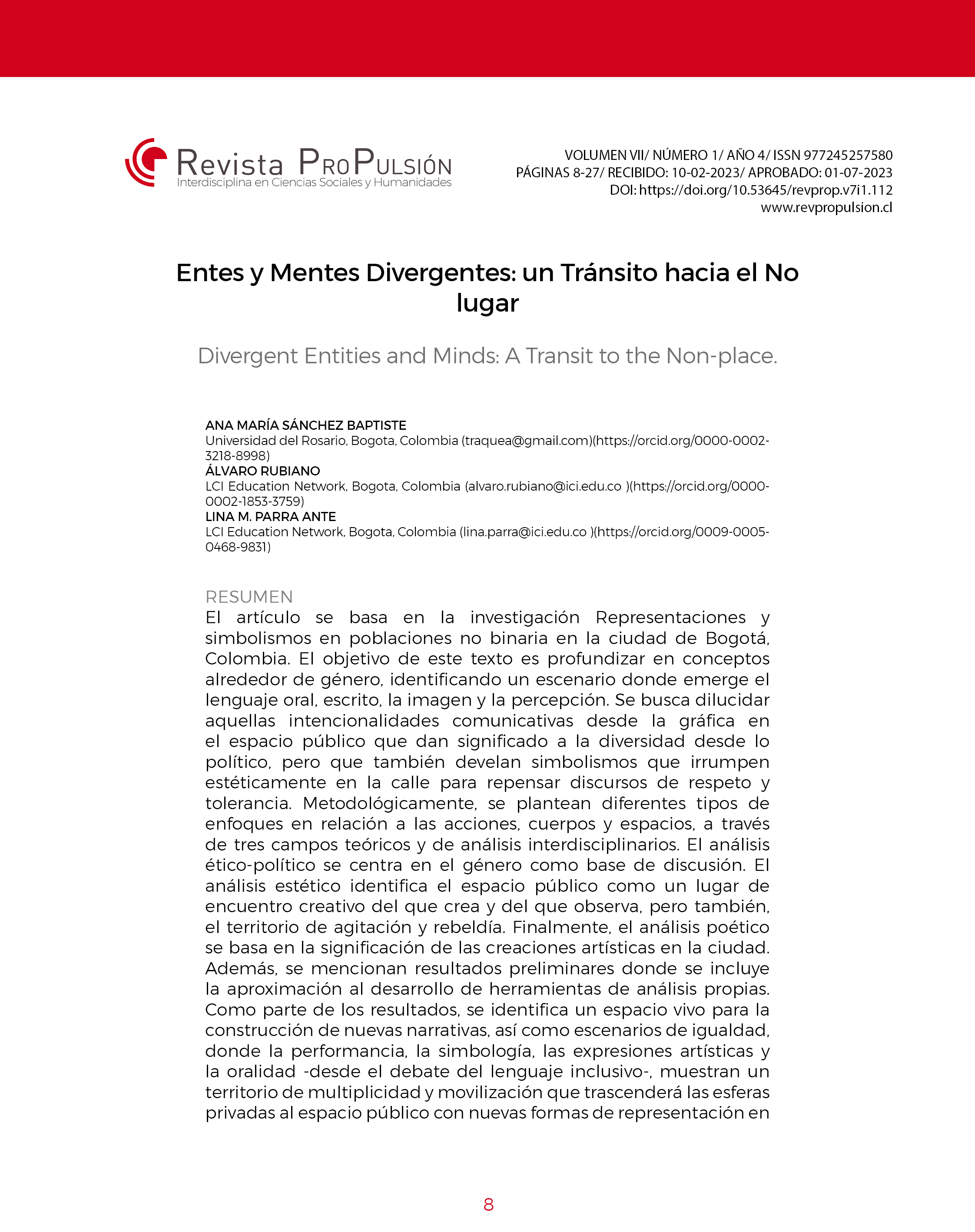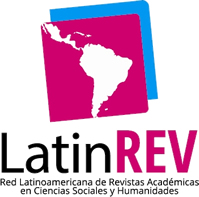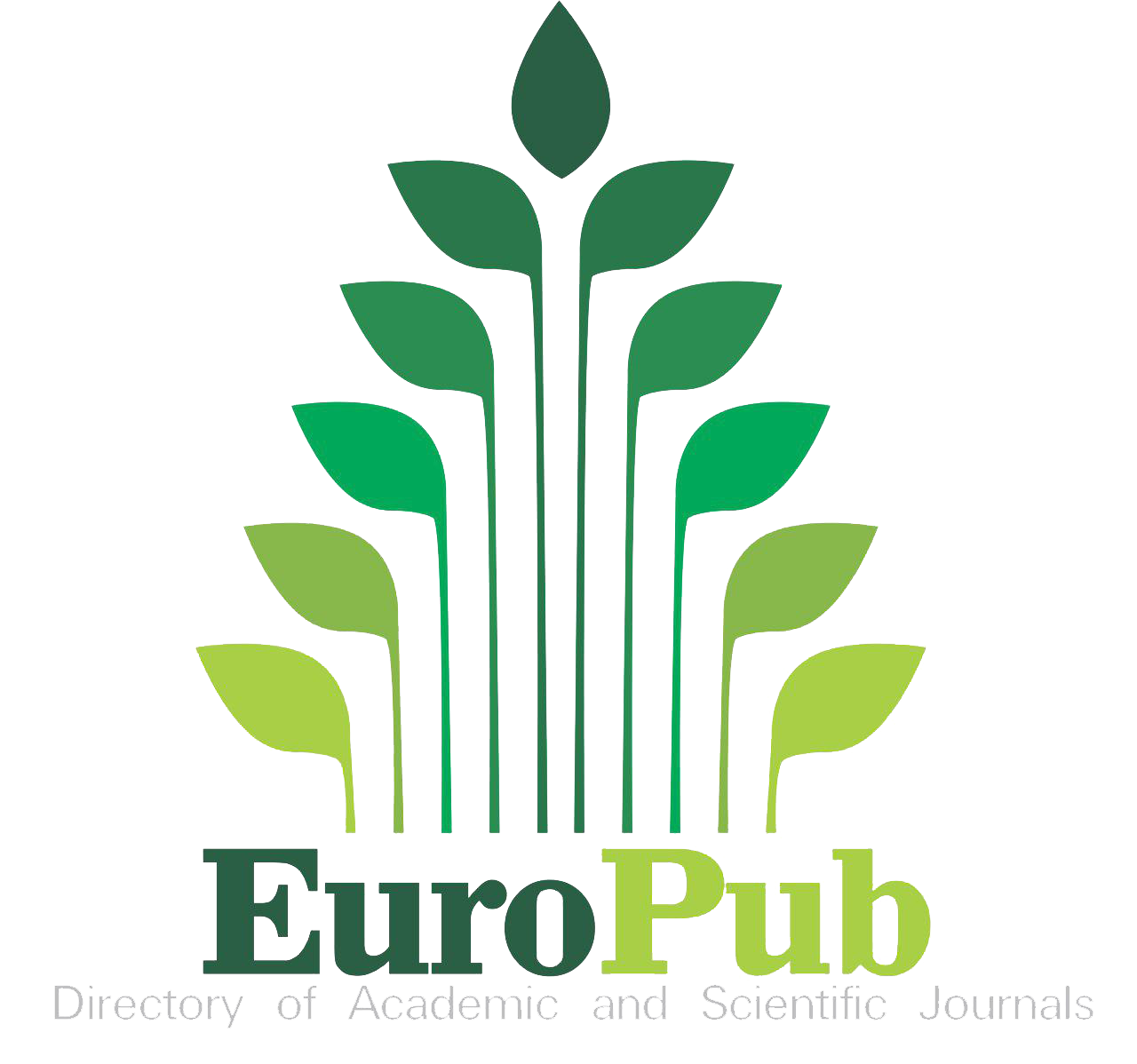Entes y mentes divergentes: un tránsito al no lugar.
DOI:
https://doi.org/10.53645/revprop.v7i1.112Palabras clave:
género no binario, representaciones simbólicas, cultura queer, performancia, lenguaje inclusivo, metodología semiológica, estudios subculturalesResumen
El artículo se basa en la investigación "Representaciones y simbolismos en poblaciones no binarias" en la ciudad de Bogotá, Colombia. El objetivo de este texto es profundizar en conceptos alrededor de género, identificando un escenario donde emerge el lenguaje oral, escrito, la imagen y la percepción. Se busca dilucidar aquellas intencionalidades comunicativas desde la gráfica en el espacio público que dan significado a la diversidad desde lo político, pero que también develan simbolismos que irrumpen estéticamente en la calle para repensar discursos de respeto y tolerancia. Metodológicamente, se plantean diferentes tipos de enfoques en relación a las acciones, cuerpos y espacios, a través de tres campos teóricos y de análisis interdisciplinarios. El análisis ético-político se centra en el género como base de discusión. El análisis estético identifica el espacio público como un lugar de encuentro creativo del que crea y del que observa, pero también, el territorio de agitación y rebeldía. Finalmente, el análisis poético se basa en la significación de las creaciones artísticas en la ciudad. Además, se mencionan resultados preliminares donde se incluye la aproximación al desarrollo de herramientas de análisis propias. Como parte de los resultados, se identifica un espacio vivo para la construcción de nuevas narrativas, así como escenarios de igualdad, donde la performancia, la simbología, las expresiones artísticas y la oralidad -desde el debate del lenguaje inclusivo-, muestran un territorio de multiplicidad y movilización que trascenderá las esferas privadas al espacio público con nuevas formas de representación en esa búsqueda de entendernos y reconocernos.
Descargas
Citas
Alexander, J; Yescavage K, (2004), Bisexuality and Transgenderism: InterSEXions of The Others.
Boyd & Richerson (1985), Culture and the evolutionary process.
Butler, J. (1999). El género en disputa, El feminismo y la subversión de la identidad, Título original: Gender Trouble.Feminism and the Subversion of identity, Routledge, Nueva York, Traducción de Maria Antonia Muñoz.
Butler, J. (2004). Deshacer el género, Título orígínal: Undoing Gender Publícado en ínglés, por Routledge, Nueva York Traduccíón autorizada a partir de la edición en lengua inglesa publicada por Routledge, parte de Taylor & Francis Group LLC.
Barthes, R. La aventura semiológica, (1985) Título original: L 'aventure sémio/ogique Publicado en francés por Éditions du Seuil, París Traducción de Ramón Alcalde.
Cepeda-Bolívar, J. P. (2017). Agenciamiento político y subjetividad política de la Red Comunitaria Trans en Bogotá, Colombia. Jangwa Pana, 16(2), 169–178.
De Lauretis, T. (1957), Technologies of Gender. Indiana Universiy Press.
De Lauretis, T. (2010). Teoría queer. Sexualidades lesbiana y gay, traducción de Mauricio Sáenz Ramírez. En: List Reyes, Mauricio y Teutle López, Alberto (Coords.). Florilegio de deseos: Nuevos enfoques, estudios y escenarios de la disidencia sexual y genérica. México: Eón.
Gianneschi, H. (2011) Algunas consideraciones sobre la tesis aristotélica ‘el ente no es un género’. En: Philosophia, No. 71, p. 111-130.
Heidegger M (1983). El principio de identidad, unirioja.es.
Louro, G. L. (2004). Um corpo estranho: ensaios sobre sexualidade e teoria queer. Belo Horizonte: Autêntica Editora.
MacKinnon, C. (1989). Hacia una teoría feminista del estado. Ediciones Cátedra. Madrid, España.
Martin Casares, A. (2008). Antropología del género. Culturas, mitos y estereotipos sexuales. Madrid España: Ediciones Catedra Universitat de Valencia. Instituto de la Mujer.
Ministerio de Educación Nacional de Colombia, (2020). Enfoque e identidades de género los lineamientos política de educación superior inclusiva.
Olivos S. L. (2002). Sujeto de la política, sujeto de la igualdad. A propósito de Rancière
Revista Mexicana de Ciencias Políticas y Sociales, vol. XLV, núm. 184, enero-abril, pp. 189-201.
ONU Mujeres, (2019). Estrategia para Todo el Sistema sobre la Paridad de Género.
OSAGI, Gender Mainstreaming - Concepts and definitions
Pérez Porto, J., Gardey, A. (2010). Ente - Qué es, definición, historia y en el lenguaje coloquial.
Presentes Agencia, (17 de mayo de 2020). Qué significa la sigla lgbtiq.
Rancière, J. (1996), El desencuentro. Política y filosofía, Buenos Aires, pp. 145-152.
Serrano, H. et al (2011). Códigos visuales de género y configuraciones sexuales evidenciadas en la fotografía. Revista Latinoamericana de Ciencias Sociales, Niñez y Juventud, Vol. 9 no. 2 jul-dic. Manizales.
Sierra, González. Á. (2008). Una aproximación a la teoría queer: el debate sobre la libertad y la ciudadanía.
UN Women, OSAGI. Gender Mainstreaming - Concepts and definitions ( 2001)

Publicado
Cómo citar
Número
Sección
Categorías
Licencia
Derechos de autor 2023 Ana Sanchez, Rubiano & Parra

Esta obra está bajo una licencia internacional Creative Commons Atribución-NoComercial 4.0.
- Esta licencia permite a los reutilizadores distribuir, remezclar, adaptar y construir sobre el material en cualquier medio o formato solo con fines no comerciales, y solo mientras se dé atribución al creador.Incluye los siguientes elementos: POR – Se debe dar crédito al creador NC – Solo se permiten usos no comerciales de la obra.







